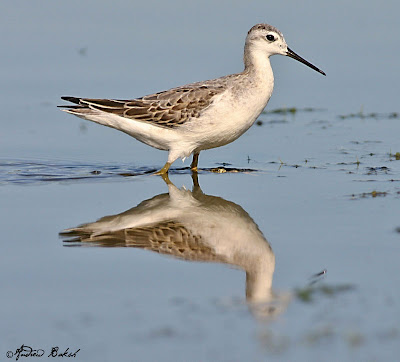
The very next day after landing my first of the year Avocet at Jamaica Bay. I was on the East Pond on the North End, when I saw my second Avocet. This one was a lot lighter in color and the bill was not as upturned as the one from August 19th.
In my last post, I did not get too much into the American Avocet (Recurvirostra americana), so I will take some time to provide a bit more information. The American Avocet, is a Long-legged shorebird characterized by long, thin upcurved bill and distinctive black and white back and sides. The head and neck are bright rust-brown during summer. The female has a shorter, more upcurved bill; the bird that I had on the 19th, I think fits the profile of a female. A winter adult Avocet, resembles a breeding adult but head and neck are pale gray. The juvenile is similar to adults but has a pale rust-brown wash over gray head and neck.
American Avocet, breeds from interior Washington, Saskatchewan, and Minnesota south to California and Texas. It spends winters on the west coast north to California, on the Gulf Goast, and in Florida. In fall, this bird is a regular visitor on the Atlantic coast. Preferred habitats include freshwater marshes and shallow, marshy lakes. It breeds locally in salt or brackish marshes; often moving to coasts during winter. I was able to get good looks and some decent photos of this bird.
Thrilled at having my second Avocet in as many days, it then got even better, as I picked up in my scope not one or two, but three Wilson's Phalarope (Phalaropus tricolor) on the Pond. This was a record for me at the East Pond, as I have never had three of them together at one location. I was lucky to get some good photos of these beautiful birds and took some time to observer their feeding habits. Wilson's Phalaropes are really something to watch as they feed. The phalarope spins in circles on the water, as it forages for food. The whirling motion creates a vortex that brings food to the surface. Then, the phalarope picks off the morsels of food.
In breeding plumage, adults of both sexes have black legs. During the non-breeding season, both sexes look similar--gray above and white below, with yellow legs. Their faces are white, and their throats are gray. In flight, they are solid white below. Their wings are solid gray, with no white stripe. They have white rumps and light gray tails. Juveniles look similar but are mottled gray-brown above.
Wilson's Phalaropes are found mostly on fresh water, but during migration they can also be found in small numbers on salt water. They breed in shallow, prairie wetlands in the northern US and southern Canada. During migration, they inhabit shallow ponds, flooded fields, and sometimes mudflats. Wilson's Phalaropes winter on large, shallow ponds and saline lakes in southern South America.
 The first Wilson's Phalarope that was seen on the pond with a Greater Yellowlegs.
The first Wilson's Phalarope that was seen on the pond with a Greater Yellowlegs. A few minutes later, there were two Wilson's Phalaropes that showed up in the scope.
A few minutes later, there were two Wilson's Phalaropes that showed up in the scope. As if two were not enough, a third Wilson's Phalarope showed up.
As if two were not enough, a third Wilson's Phalarope showed up.Tags:




























